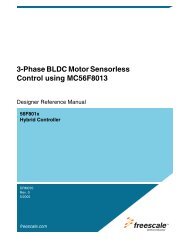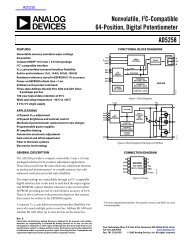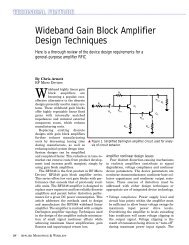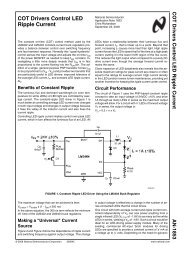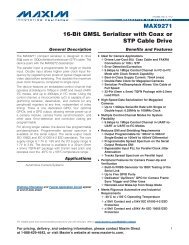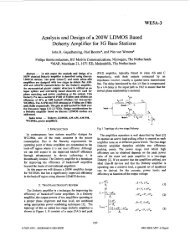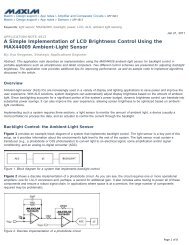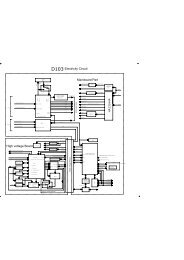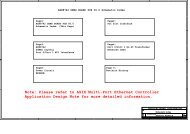A Multi-Carrier UHF Passive RFID System
A Multi-Carrier UHF Passive RFID System
A Multi-Carrier UHF Passive RFID System
You also want an ePaper? Increase the reach of your titles
YUMPU automatically turns print PDFs into web optimized ePapers that Google loves.
whose diagrammatic sketch is shown in Figure 1(b).<br />
The proposed system not only can provide sufficient<br />
energy to Gen2 tags but also can extend its accessible<br />
range. Furthermore, taking the advantages of multiple<br />
carriers, the reader can be benefited from the frequency<br />
diversity gain and the multipath fading problem can be<br />
mitigated.<br />
The remainder of this paper is organized as follows:<br />
Section 2 introduces the proposed system. Section 3<br />
presents the experimental results. Section 4 draws<br />
conclusions.<br />
2. The <strong>Multi</strong>-carrier <strong>UHF</strong> passive <strong>RFID</strong><br />
system<br />
Unlike the integrated reader in an ordinary <strong>UHF</strong><br />
passive <strong>RFID</strong> system, the reader in a multi-carrier <strong>UHF</strong><br />
passive <strong>RFID</strong> system is decomposed into two parts: a<br />
CW emitter (CWE) and a transceiver. The CWE can be<br />
preset leaky cables or radio source(s) close to tags,<br />
which emit a CW with frequency f<br />
c<br />
to illuminate tags.<br />
The CWE constantly provides energy and the MBS<br />
carrier(s) to the tags. The transceiver, which can be<br />
farther away from the tags, is mainly used to transmit<br />
the R-T commands and receive the T-R responses.<br />
As illustrated in Figure 1(b), the received power of<br />
the tag<br />
P<br />
'<br />
tag<br />
can be presented as Eq.(3).<br />
2<br />
' ' ⎛ λ ⎞<br />
c<br />
tag<br />
=<br />
cw ⎜ ⎟ cwe tag<br />
4π<br />
d1<br />
P P G G , (3)<br />
⎝ ⎠<br />
where P denotes the power of the CW emitted from<br />
'<br />
cw<br />
the CWE,<br />
λ<br />
c<br />
is the wavelength of the CW, and d 1<br />
is<br />
the distance between the CWE and the tag.<br />
G cwe<br />
and<br />
G<br />
tag<br />
are the power gains of the CWE and tag antennas<br />
respectively. In addition, the power of the MBS<br />
received at the reader<br />
P can be written as Eq.(4).<br />
'<br />
rx<br />
2<br />
' '<br />
⎛ λ ⎞<br />
rx<br />
=<br />
tag ⎜ ⎟ rx tag<br />
4π<br />
d2<br />
P P G G , (4)<br />
⎝ ⎠<br />
where G is the power gains of the transceiver, and<br />
rx<br />
d<br />
2<br />
is the maximum accessible distance between the<br />
transceiver and the tag. Assuming that the antenna<br />
gains of the CWE and the transceiver are the same as<br />
that of the integrated reader in an ordinary system<br />
( Gcwe = Grx = Greader<br />
), and the CW frequencies and<br />
powers in both systems are the same<br />
'<br />
( λ = λc,<br />
Pcw = Pcw), the power of received MBS in<br />
both system can be written as Eq.(5).<br />
' 4<br />
Prx<br />
d0<br />
= . (5)<br />
2 2<br />
Prx<br />
d1d2<br />
'<br />
When d1 < d0<br />
and Prx<br />
= Prx<br />
, d2 > d0<br />
can be<br />
derived. In other words, given the same receiver<br />
sensitivity and the same CW emission power, the<br />
proposed system can effectively extend the accessible<br />
distance between a tag and the receiver. Moreover,<br />
because the tags are plentifully illuminated by the<br />
CWE, the problem of insufficient tag operation energy<br />
is avoided.<br />
A simplified normal operation flow of the proposed<br />
system is illustrated in Figure 2. Before issuing an R-T<br />
command, the transceiver turns on the CWE to emit the<br />
CW, so that the tags nearby the CWE are powered up<br />
and ready for the R-T command. When the accessing<br />
operation is finished, the transceiver turns off the<br />
CWE, and the operation is then terminated.<br />
The proposed system may seem similar with an<br />
ordinary Gen2 system, except the additional CWE. As<br />
a matter of fact, they are substantially different. We<br />
discuss three major differences as below:<br />
2.1. The frequency difference between the<br />
transceiver and the CWE<br />
Because the transceiver and the CWE are<br />
separated in our proposed system, the carrier frequency<br />
of the transceiver ( f<br />
t<br />
) and the frequency of CW ( f<br />
c<br />
)<br />
emitted by the CWE can be different. Assuming the<br />
noise is negligible, the RF signal received by a tag can<br />
be expressed as Eq.(6).<br />
s t = m t cos 2π f t + Acos 2π f t+ φ t , (6)<br />
() () ( t ) ( c ())<br />
where<br />
⎧A , when high level is sent<br />
m()<br />
t =<br />
t<br />
⎨ denotes the<br />
⎩ 0, when low level is sent<br />
waveform of an R-T command from the transceiver,<br />
A denotes the amplitude of the RF signal transmitted<br />
t<br />
by the transceiver, A denotes the amplitude of the CW<br />
emitted by the CWE, and φ () t is the phase different<br />
between the two carriers. Let ∆ f = fc − ft<br />
. After<br />
some manipulations, Eq.(6) can be rewritten as Eq.(7).<br />
s( t) = ⎡<br />
⎣m( t) + Acos( 2π∆ ft+<br />
φ( t)<br />
) ⎤<br />
⎦cos( 2π<br />
ftt)<br />
.(7)<br />
+ Asin 2π∆ ft+<br />
φ t sin 2π<br />
f t<br />
( ()) ( t )<br />
The signal s()<br />
t is firstly passed through the<br />
envelope detection circuit inside the tag IC as shown in<br />
Proceedings of the 2007 International Symposium<br />
on Applications and the Internet Workshops (SAINTW'07)<br />
0-7695-2757-4/07 $20.00 © 2007


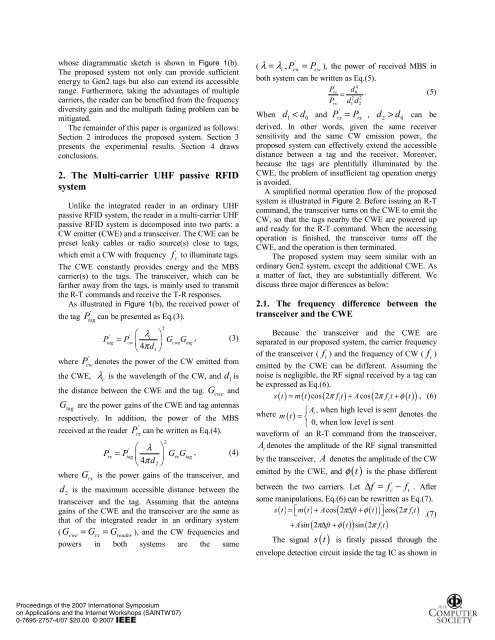
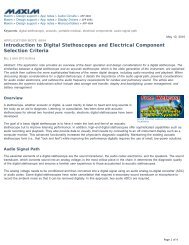
![P-CAD EDA - [Sheet1]](https://img.yumpu.com/49470492/1/190x115/p-cad-eda-sheet1.jpg?quality=85)
